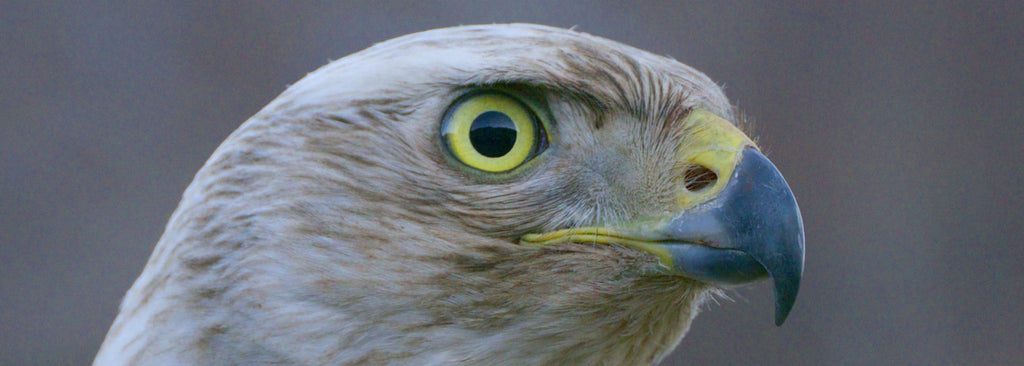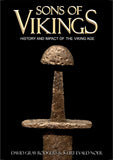Thanks for visiting our blog! As a thank-you, enjoy 15% off your first order in our online Viking Shop with the discount code BLOG15.
In the long struggle for survival, humankind has found help by forming relationships of symbiotic cooperation with animals. Horses enabled us to cover ground, oxen increased our work capacity, and dogs helped us hunt or herd. People have made up for some of the limitations of our species by harnessing the strengths of others. One of the most impressive and dramatic applications of this principle is falconry – using birds of prey to catch game.
There are references to falconry in Assyria and China, both going back to the 7th century B.C. The techniques of training these natural-born killers to catch and retrieve other birds and small mammals spread over Eurasia in the centuries that followed. But it was in the Middle Ages that falconry had its real heyday and shifted from a clever means of supplementing the diet to a true sport of kings. The Vikings employed falconry and enjoyed its benefits, and they played a large role in its spread and prestige.
Viking Birds
 By far the bird most associated with the Vikings is the raven. Ravens were symbols of Odin, and imagery of their feasting on the bodies of the battle-slain are ubiquitous in Norse poetry. According to the Landnámabók, Floki, the 9th century Viking, discovered Iceland by releasing three ravens and following their flight.
By far the bird most associated with the Vikings is the raven. Ravens were symbols of Odin, and imagery of their feasting on the bodies of the battle-slain are ubiquitous in Norse poetry. According to the Landnámabók, Floki, the 9th century Viking, discovered Iceland by releasing three ravens and following their flight.
With the common knowledge of Odin's two raven pets (Huginn and Muninn), who were given the magical ability to speak about what they saw and hear, it makes perfect sense that Vikings were intrigued and excited about the idea of training large birds of prey to hunt for them.
Ravens are exceptionally intelligent, good hunters, and capable of learning, but humankind has seldom been able to make consistent use of these magnificent, mysterious birds. One reason for this may be that ravens rely on their complex social structures and are not solitary predators like falcons, eagles, or hawks. It would seem ravens were pleased to follow Odin but quickly lose interest in humans.
Falcons, hawks, and even eagles were a much better match. They are highly trainable (with skill and patience), and they have the size and strength to retrieve game worth eating. Their fantastic eyesight and astounding dive speeds (sometimes in excess of 200 mph) make them some of nature's most perfect predators. With the help of such birds, a Viking could make a fine dinner of meat and foul he ordinarily would not have even known were there.
Germanic tribes were using falconry by the 6th century A.D. The Saxon kings of Britain were avid falconers at the dawn of the Viking Age. Even Alfred the Great would not let his illness stop him from going out and hunting with his birds.
 The Norse of Scandinavia were not ones to be left behind. Some graves in Norway and Sweden from the Vendel period and Viking Age contained the bones of falcons along with the high-status warriors interred there. Archaeologists have found other graves and treasure hordes that contained small iron or copper bells that may be associated with falconry. In addition to this material evidence, there are runestones that depict hunters with dogs and falcons, including those at Alstad, Toten (Norway), and Böksta, Uppland (Sweden).
The Norse of Scandinavia were not ones to be left behind. Some graves in Norway and Sweden from the Vendel period and Viking Age contained the bones of falcons along with the high-status warriors interred there. Archaeologists have found other graves and treasure hordes that contained small iron or copper bells that may be associated with falconry. In addition to this material evidence, there are runestones that depict hunters with dogs and falcons, including those at Alstad, Toten (Norway), and Böksta, Uppland (Sweden).
There are numerous references in the historical record to the Viking use of falcons, hawks, and other birds of prey. According to a Frankish source, the 8th-century Danish king Godfred was assassinated on a hunting trip as he was about to release his hawk. King of Norway Olav Tryggvasen (Leif Erikson’s mentor) reportedly ripped the feathers from his sister’s falcon in a particularly-unattractive fit of rage. King Haakon the Good’s tribute paid to King Harald Bluetooth included 60 hawks or falcons.
One gets a sense for the awe that Vikings held for falcons, hawks, and eagles by reading Norse mythology and poetry. The goddess Freya has a cloak of falcon feathers that she can don whenever she wants to fly. Loki sometimes borrows this cloak to spy on enemies or travel to the home of the giants. The goddess Frigg (Odin's wife) has a similar cloak. When Odin stole the Mead of Poetry from the giants, he changed his shape into an eagle to make his lightning-fast getaway.
The Viking Falcon Trade
 Vikings were not just raiders and explorers but were avid traders. They used their extensive networks, their adaptable ships, and their matchless daring to bridge the farthest reaches of the cold North Atlantic to the opulent kingdoms of a golden age East. One of the most sought-after, expensive, and coveted items Vikings purveyed were hunting falcons – especially the large, snowy-white gyrfalcon of the far north. These magnificent birds were worth much more than their weight in gold and were considered the ultimate status symbol and gift for kings.
Vikings were not just raiders and explorers but were avid traders. They used their extensive networks, their adaptable ships, and their matchless daring to bridge the farthest reaches of the cold North Atlantic to the opulent kingdoms of a golden age East. One of the most sought-after, expensive, and coveted items Vikings purveyed were hunting falcons – especially the large, snowy-white gyrfalcon of the far north. These magnificent birds were worth much more than their weight in gold and were considered the ultimate status symbol and gift for kings.
To illustrate just how much value was placed on these birds: During one of the Crusades, an Ottoman sultan refused a ransom of 200,000 gold ducats for a captured prince, insisting on 12 gyrfalcons instead.
Erik the Red and his hardy Viking settlers of Greenland knew that they could not scratch out enough food from that barren island, but the gyrfalcons and walrus ivory they could export would make them rich.
Of course, the Viking falcon trade was not exclusively these big-ticket items. The 11th century Domesday Book of newly-Norman England describes the extensive imports of various types of hawks and falcons from Norway that had been taking place for years.
The popularity of falconry would continue to rise after the Viking Age had declined. In the High Middle Ages, it became common across many social classes and was enjoyed equally by both genders. The type of bird used, though, became strictly associated with status and there were even laws that prevented someone from owning a bird above his station. It became so fashionable to own a hunting bird that bishops demanded that men and women not bring their falcons to church. The most valued birds continued to form part of paid tributes and even to seal peace treaties. The same sleek, fast, agile, and strong birds that they Vikings favored became the prized possessions of aristocrats and royalty.
For the Vikings, the falcon was a hunting partner and a source of sport, wealth, and inspiration. Even today, anyone who sees a display of falconry cannot help but be impressed by the creature's abilities, the trainer's skill, and the ingenuity of our many ancestors who realized the potential of this partnership.

Mike Dupuy of MikeDupuyFalconry.com and Kurt Noer of SonsOfVikings.com
Sons of Vikings is an online store offering hundreds of Viking inspired items, including Viking jewelry, Viking clothing, Drinking horns, home decor items and more.
To learn more about Viking history, we recommend our 400+ page, self titled book that is available here.
Images Source: https://mikedupuyfalconry.com/
References
- Rodgers, D. G. & Noer, K. (2018). Sons of Vikings: History, Legends, and Impact of the Viking Age. Kindle Direct Press, United States.
- Brown, N.M. (2015). Ivory Vikings: The Mystery of the Most Famous Chessmen in the World and the Woman Who Made Them. Martin’s Press, New York.
- Forsyth, W. (n.d.) The Noblest of Sports: Falconry in the Middle Ages. Metropolitan Museum of Art, New York. https://www.metmuseum.org/pubs/bulletins/1/pdf/3257142.pdf.bannered.pdf
- S. (n.d.). Ancient & Medieval Falconry: Origins and Function in Medieval England. Richard III Society. http://www.r3.org/richard-iii/15th-century-life/15th-century-life-articles/ancient-medieval-falconry-origins-functions-in-medieval-england/
- Stylegar, F.A.H. (2006). Viking Age Hawking. Arkeologi. http://arkeologi.blogspot.com/2006/06/viking-age-hawking.html
- Ellwood, T. (1898). The Settlement of Iceland: Ari Frodi(Landnámabók). https://ia801406.us.archive.org/29/items/booksettlementi00ellwgoog/booksettlementi00ellwgoog.pdf


